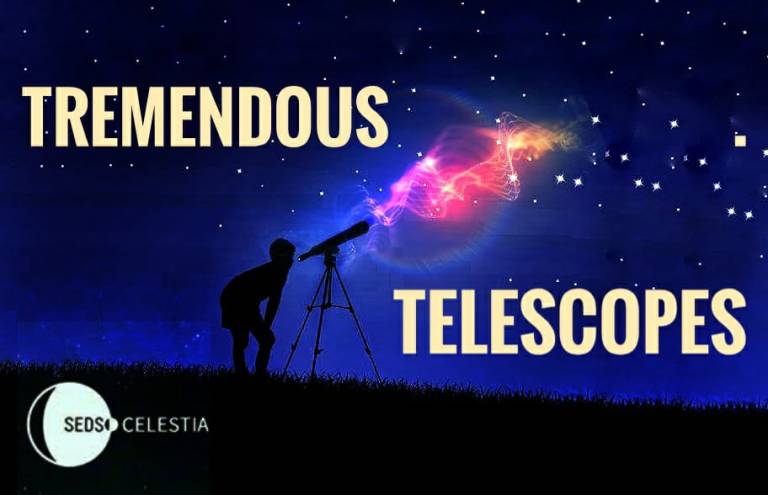Understanding Telescopes and Binoculars - Part2

Part 2: Tremendous Telescopes
So, I’m assuming you’ve read the first article of this series, and are now the proud owner of your very own pair of shiny, cool binoculars! Great! But if you’re anything like me, you want the real stuff (wink). The stuff that will get you as high up as the stars themselves, so close that you can reach out and touch them (and get vaporized into a gazillion particles too, but I try not to think that far ahead). I’m talking, of course, about telescopes!
Telescopes are a bit complicated. Okay, maybe they’re very complicated, at least to the uninitiated. But don’t worry, if you understand the principles, and practice a bit, you can use one too, and I assure you, the results will blow your mind. Telescopes, even small, backyard ones, are capable of showing you some of the most beautiful and amazing things in our wonderful universe. You can glimpse some of the most awe-inspiring things in the night sky, stuff that you only read in some book or article, stuff that would not be out of place in a fantasy novel. You can have all of that, if you learn how to use a telescope; which brings us back down to earth, to the basics.
Now, since you’ve read the previous article, let’s try to build on your understanding. Imagine that we take your shiny, new, cool pair of binoculars, and, umm, cut it in half right down the centre (sorry!). Take one half, and make it bigger. Way, way bigger, until it’s as big as you are (if you’re about 4 feet tall). Next, since it’s too heavy to use with your hands, you mount it on a stand. What kind of stand, if it has 3 legs, 4 legs, or no legs at all, we’ll see later. Now, if you are used to getting down to your knees a lot, you can leave the eyepiece down at the bottom of the tube. Since it is bigger, it’s now more difficult to find stuff in the sky, so you take the other half of your binoculars, and stick it on the side of your imaginary telescope. You can use this to find the rough position of objects, and then use the main eyepiece to make final adjustments. Et voila, you have now achieved a refractor, or Galilean telescope!
Seriously, though, putting all jokes aside (for now), a refractor is just that; a long tube with lenses at either end. A convex lens acts as the objective, collecting light from objects, which then passes through a concave lens at the other end of the tube and makes its way into your eyes. Since it’s the bigger, badder version of the binoculars, it has much higher magnification, which, if you remember, results in a really tiny field of view. Because you’re looking at such a small part of the sky, it can become very difficult to actually find stuff. Hence, all telescopes come equipped with a smaller, mounted scope or simple cross-hair, like a sniper rifle. This is called the finder scope, and as the name implies, it helps you find the object you’re looking for. This entire apparatus is attached to a mount that can move smoothly so that the telescope can point to any part of the sky. Refractors are sturdy and need little care and maintenance, since the lenses are quite strong and the inside of the tube is sealed off from the atmosphere. However, lenses are quite heavy, and get heavier and heavier as the aperture increases. Another disadvantage of using lenses is that lenses bend the light, and different wavelengths bend differently. It looks very pretty when you make a rainbow through a prism, but here is creates quite the problem. This effect, called “chromatic aberration”, is mitigated using correcting lenses, but is a fundamental flaw of using lenses.
Now, continuing with our maiming of your binoculars, imagine that you have a crazy brother. He has his own binoculars, and since he’s got nothing to do he’s copied you so far, but he’s lazy, and gets bored easily. So, just for kicks, he modifies the design a bit, throwing out the objective and putting in a mirror at the base of the tube instead, and another smaller mirror at the top, pointing sideways. He now has a smaller, fatter tube, with a mirror inside and the eyepiece on the side. Later that night, you both head out to test your instruments. You’re waiting outside while two servants haul your heavy refractor out into the open, while your brother saunters over, his telescope nonchalantly perched on his shoulder. You laugh scornfully at his absurdly fat telescope, with nothing on the top as you look inside, seeing an ugly warlock looking back at you. You jump back in horror, but realise it’s a mirror (hey, wait a minute) and head back to your own refractor which is still being set up, thinking that his design will never work. One last look at him and you see his smug face as he plops his bazooka-esque apparatus down and leisurely swings it around, as you impatiently wait for your servants to maneuver you unusually heavy telescope onto its stand.
Okay, so coming back to the present, your imaginary brother was Newton (surprise!) and his telescope, logically enough, is called a Newtonian, or reflector. The light is gathered using a mirror instead of a lens, which has several advantages. It isn’t as heavy, the light isn’t lost in the lens, and the eyepiece can be attached further up the tube, which makes the viewing angles much less awkward. It isn’t all sunshine and daisies, though, as your mirror is exposed to the atmosphere, and hence dust, water, etc can cloud and damage the mirror, the optical components are more prone to go out of alignment, and temperature changes can also make a difference in the clarity of the image. Overall, this design is a bit more delicate, as the mirror can shatter, but it is also much lighter, and easily portable and gives a brighter image than the refractor. Reflectors are cheaper to make, and as big as you want them. There is another variation of the reflector called the Cassegrain telescope. The major difference is that the Cassegrain still has its eyepiece at the bottom of the tube, seen through a hole in the objective mirror.
Finally, let’s move on to what your younger brother is doing. Oh, you don’t have a younger brother? Well now you do. And he’s obsessed with Dragon Ball Z. One night you catch him in the store room where your telescopes are kept. He’s moving around a lot with your precious instruments, for some strange reason. Suddenly there’s a flash of light, and a big BOOM!!! Horrified, you run in to see what has happened, and your eyes fall on this strange, new telescope standing in the middle of the room. Of your brother, there’s no sign (good riddance, you think). Cautiously, you step closer and examine this new telescope, It’s very similar to the Cassegrain we talked about earlier, with a mirror at the bottom, another smaller mirror in the center of the aperture, and the eyepiece way down at the bottom. It’s also much shorter and fatter, and has a lens across the aperture. This telescope, born of a fusion dance of the reflector and a refractor, is called a Catadioptric telescope.
Essentially, that is what it is; it makes use of both lenses (dioptrics) and mirrors (catoptrics) to present the image. Similar to the Cassegrain, the light is reflected twice inside the tube, hence the size of the telescope is much shorter than the other varieties. This makes the catadioptric much more compact and portable. The lens and mirrors are not that complicated to make, and hence the telescope is cheaper than you’d expect. However, as any optical engineer will tell you, “Every optical design is always a compromise!” The catadioptric suffers from many of the pitfalls of the reflector telescope, as it is delicate, goes out of alignment more often, and as an added problem, the construction of this telescope is more complex, and as such more difficult to solve it’s problems.
Now that you know about the 3 main types of telescopes, let’s move on to the finer details of a telescope. Similar to the binoculars, the aperture is a very important aspect of the telescope, as it governs how bright your images will be. Next, the focal ratio of the objective decides a lot of factors, like how long your telescope is going to be, and the magnification. However, we rarely look at the focal length by itself; we instead focus (hah!) on a number called the focal ratio. The f-ratio is the focal length divided by the aperture and is probably the most informative and important factor for a telescope. A larger f-ratio implies more magnification, but a narrower FoV and a dimmer image, which is great for viewing brighter stuff that has a lot of detail, like the moon, or the planets. A lower f-ratio, on the other hand, collects more light, shows more of the sky, but gives less magnification. A lower f-ratio is usually desired when viewing extended objects like nebulae and galaxy. It is also important for your telescope to pick out small details; this ability is called the resolving power. It is directly proportional to the aperture; a bigger aperture can distinguish more details. And finally, we come to eyepieces. Contrary to binoculars, ‘scopes come equipped with multiple, interchangable eyepieces, as eyepieces decide how magnified the image will be. The formula for magnification is simple; F/f, where F is the focal length of the objective, f of the eyepiece. There are limits to the magnification, however, as every small movement and disturbance is magnified when using a telescope. After a certain point even extremely minute disturbances like an imperceptible breeze, or even the breath of the user, can make the view useless. Usually, a magnification of 50x aperture in inches is the limit, though this isn’t a set rule, more of a guideline.
You made it to the end, great! Well you know now the most popular types of amateur telescopes, and how they work! Am I ready to wield a telescope then, sensei, you may ask. Not quite yet, though you’re well on your way. Next we’ll understand how telescope mounts move and work, since they’re as important as the telescopes themselves, and a good understanding of their co-ordinate systems will lead to a much cleaner and enriching view of the night sky.

